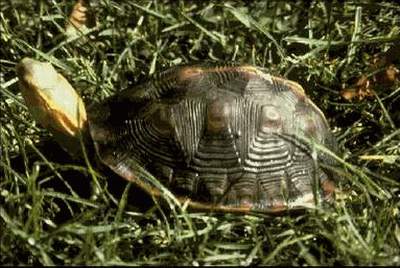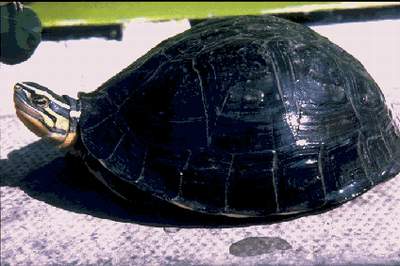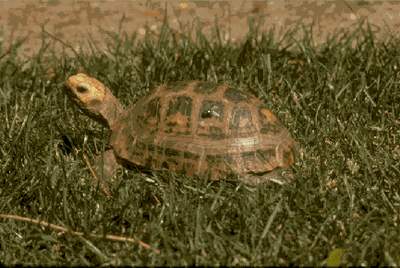Most of the Asian importations seem to be the Asian Box Tortoise species (Cuora spp), similar in diet and environmental requirements to the American Box Tortoises, needing to be kept under conditions of high humidity with constant access to fresh water and a diet of both meat and fruit.
The Southeast Asian Box Turtle (Cuora amboinensis) is semi-aquatic, mainly vegetarian and grows to up to eight inches. It has a distribution from eastern India and Bangladesh through Burma, Thailand and Vietnam to the Malay Peninsula and throughout the Malayan archipelago, Indonesia and the Phillippines.

The Chinese Box Turtle (Cuora flavomarginata) from southern China, Taiwan and Ryukyya Islands, has a size of four to seven inches. It cannot tolerate cold temperatures, is omnivorous and feeds both on land and in shallow water, where it is reported to feed on fish as well. Breeding takes place in spring and several single egg clutches per year are laid. India is home to 22 species of freshwater terrapins and 4 species of land tortoises. The reptiles, like everywhere else, have been exploited as a food for centuries. Indigenous peoples in all parts of the country use the shell, eggs, blood, gall bladder and meat of the animals to treat skin diseases, stomach ailments, cuts and burns. Trade in freshwater terrapins and tortoises is banned under India's Wildlife Protection Act. This ban includes the Indian Star Tortoise, Geochelone elegans, which is highly sought after by the international pet trade and it is estimated that in spite of the ban between 10.000 and 15.000 Indian Star Tortoises still find their way every year to Southeast Asia, the Gulf and Europe.

THE INDIAN STAR TORTOISE (Geochelone elegans)
HABITAT: Arid lands
RANGE: India, Pakistan and Sri Lanka
FEATURES: The Star Tortoises are easily recognised by their beautiful appearance with the star-like pattern on their carapace. Females have broader shells, males have narrower, smoother shells which are not so beautifully marked. Feeding and activity take place early morning and late afternoon, except during the rainy season (mid-June - mid-October) when the animals are active all day and copulation takes place with males trying to turn each other over. Clutches of three to six hard-shelled eggs are laid; sometimes several clutches in one year. They are closely related to the African Leopard Tortoise (G.pardalis) and should receive similar treatment. The animal does not hibernate.
FEEDING: native : the principal diet is grass, fallen fruit and flowers. : captive: in captivity the animals learn to eat a wide variety of food. They should have access to a lawn where they are able to crop grass. Less recognisable and still occasionally encountered are the Elongated Tortoise (Indotestudo elongata) and its close relative the Travancore Tortoise (Indotestudo forstenii).
THE ELONGATED TORTOISE (Indotestudo elongata)
HABITAT: Hilly or mountainous areas, tropical forests with an intermediate level of moisture. RANGE : Northern India and Nepal to Guangxi province of China and Malaysia.
FEATURES: The animal has a narrow, elongated, yellowish carapace (top shell), unpigmented with black spots on the vertebrals, costals and marginals. On the plastron (shell underneath) the abdominal scutes have black spots. The jaw has three sharp projections from the upper edge, e.g. it is tricuspid. With adults the interpectoral seam is slightly longer than the interhumeral seam, i.e. the seam running between the third pair of scutes on the plastron is longer than the seam running between the second pair. The reverse is true in the Travancore Tortoise. Although the animal can tolerate extreme heat, it prefers an intermediate level of moisture to dry or arid surroundings. The animal has a whitish head which during breeding time (November till January) will turn partially pink around the nose and eyes. This is due to vascularization of the sensory system associated with sex.
FEEDING: The animal is frugivorous and especially keen on exotic fruits like mango, melon, banana and peach but in captivity will learn to eat others like tomato, cucumber, apple (often stewed rather than fresh). Some people have reported their animals eating greens like lettuce and cabbage. Obviously a diet as varied as possible is in the interest of the animal. Feed a vitamin and mineral supplement and make sure they are given a warm bath once or twice a week, as this helps them to eliminate waste material. It is of the same habitat and closely related to the Travancore Tortoise (Indotestudo forstenii) and formerly called Geochelone travancorica.
THE TRAVANCORE TORTOISE (Indotestudo forstenii)
RANGE: Celebes and Halmahera Island, Indonesia; and Kerala, India.
FEATURES: The Travancore Tortoise lacks a nuchal scute, has a somewhat less elongated carapace than the Elongated Tortoise and its interpectoral seam is shorter than the interhumeral. Its usual colouration is brownish. Both tortoises should be treated in the same way. Hibernation should be avoided. During winter the animals should be kept indoors and active, preferably in a large heated vivarium, and the temperature should not go below 65°F (18°C). During the summer they may be kept outdoors on warm days, but should be brought indoors overnight.
Top




